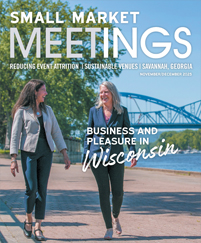Lafayette, Louisiana at a Glance
Location: Acadiana region of south central Louisiana
Access: Intersection of interstates 10 and 49; Lafayette Regional Airport; Louis Armstrong New Orleans International Airport (125 miles)
Hotel Rooms: 5,533
Contact Info:
Lafayette Convention & Visitors Commission
337-232-3737
lafayettetravel.com
Cajundome & Convention Center
Built: 1985
Exhibit Space: 72,000 square feet total space and 37,303 square feet exhibit space
Other Meeting Spaces: The Cajundome Arena seats 13,500 for sports and entertainment events. 12,000-square-foot Festival Ballroom (divisible into five breakouts); 6,075-square-foot Mardi Gras Ballroom (divisible into five breakouts); two other breakouts of 1,073 square feet each; 450 square-foot boardroom
Meeting Hotels
DoubleTree by Hilton Hotel Lafayette
Guest Rooms: 327
Meeting Space: 18,124 square feet
Home2 Suites by Hilton Parc Lafayette
Guest Rooms: 106
Meeting Space: 3,896 square feet
Hilton Garden Inn Lafayette/Cajundome
Guest Rooms: 153
Meeting Space: 3,054 square feet
Who’s Meeting In Lafayette
American Loggers Council
Attendees: 400
Louisiana Junior Beta State Convention
Attendees: 12,000
Bureau of Safety and Environmental Enforcement National Inspectors Conference
Attendees: 600
Louisiana Municipal Association Annual Conference
Attendees: 1,500
It’s easy to have fun, even at a serious meeting, in Lafayette, Louisiana. A palpable joie de vivre invigorates this city that is the heart of Acadiana, a place steeped in the spices and tradition of Cajun culture. Lafayette is alive with music, food, drink and dance. Add to that a closeness to nature — there’s a protected swamp on a university campus in the middle of town — and a spirit of hospitality that invites everyone to join the party, just as soon as the serious business is over, of course.
Destination Highlights
When a meeting concludes in Lafayette, attendees know they have visited a distinctive place. Lafayette, with a population 123,000, is the economic and cultural hub of Acadiana, Louisiana’s region created by a dramatic episode in the colonization of North America. France settled coastal Canada (Acadia) in the 1600s, but the British exiled the French colonists when they took over in the early 1700s. A wholesale expulsion ensued, and Acadians landed all along the Eastern seaboard. Louisiana, then controlled by France, became a magnet, and many Acadians made new homes there, especially west of New Orleans, working as farmers, trappers and fishermen. “Acadian” became “Cajun” over time, and the transplants were largely isolated for generations.
The Cajun culture survives and permeates Lafayette and the surrounding parishes. There really is a Cajun accent, and French words or modified French words slip into conversation and business names. Seafood and shellfish, especially crawfish and oysters, are menu favorites, and the local music is lively with the sounds of fiddle, triangle and accordion.
A living history attraction called Vermilionville tells the Cajuns’ story. It’s a representation of a village from 1765-1890 featuring 19 restored and replicated buildings. Real people bring it to life, and visitors can chat with musicians, spinners, woodcarvers and a bateau pilot who narrates tours on Bayou Vermilion. Inside a little Vermilionville house, La Cuisine de Maman restaurant, informally known as Mama’s Kitchen, is a great place to sample jambalaya, crawfish étouffée, shrimp étouffée, boudin and other Cajun treats.
The University of Louisiana at Lafayette adds another layer of vitality and activity to meetings here, and the food scene is the envy of much bigger cities. Poupart Bakery is hailed as the only authentic French bakery in Acadiana. Charlie G’s has been around more than 40 years serving smoked duck and andouille gumbo, and the Olde Tyme Grocery is famous for po’boy sandwiches.
Distinctive Venues
Vermilionville is the best-known Cajun heritage venue in Lafayette, but the Cajun story is so big that there is a second venue to consider. LARC’s Acadian Village, somewhat smaller than Vermilionville, re-creates a Cajun community complete with several houses (the oldest dates to 1800), a blacksmith shop, a doctor’s office/museum and New Hope Chapel, a replica of an Acadian chapel from 1850.
Just this year, the University of Louisiana Stadium Club became available for special events. Groups can see their logos on the stadium’s big-screen scoreboard, take photos on the field and get a football vibe even outside of football season. Keeping on the sports theme, Rock ‘n’ Bowl is a 16-lane bowling alley and party destination available for buyout rentals and for events needing fewer lanes.
The Acadiana Center for the Arts, which is celebrating 50 years of arts promotion this year, offers its 304-seat James Devin Moncus Theater (it accommodates 600 with seating removed) and several other venues for meeting events. Expected to open in 2027 is the affiliated Louisiana Music Museum, which will offer even more event space. The 2,168-seat Heymann Performing Arts Center is another cultural arts venue to consider, especially if its lineup of plays and concerts fits within a meeting calendar.
When schedules match, Tassin suggests meeting planners book around Lafayette’s two major cultural festivals. October features Festivals Acadiens et Creoles, with a food festival, art shows, craft displays and a “fais do-do,” or Cajun dance party. April delivers the even bigger Festival International de Louisiane, which organizers bill as the largest international music and arts festival emphasizing the links between Acadiana and the French-speaking world.
Major Meeting Spaces
The Cajundome & Convention Center is the city’s biggest meeting space, with 72,000 total square feet and 37,303 square feet of exhibit space. Breakout room configurations are plentiful. The Cajundome arena seats 13,500 people for University of Louisiana at Lafayette basketball games and other sports events and is also popular for concerts and large-scale convention events.
A surprise to many meeting planners is that the university has considerable meeting space for non-university clients in its student union. Danielle Tassin, senior convention sales director for the Lafayette Convention & Visitors Commission, said most of the student flow is away from the meeting space, and the building’s outdoor space is perfect for crawfish boils, receptions and other meeting functions.
“The student union also is the meeting site closest to a swamp you’ll ever book,” Tassin said. “Seeing an alligator while on a coffee break is something attendees will talk about back home. Lafayette definitely is a place to get outside of four walls.”
After the Meeting
Perhaps the most memorable post-meeting activity is taking a swamp tour — and not just a stroll past the University of Louisiana swamp. Meeting attendees can go east a few miles for an Atchafalaya Basin boat tour and a lesson about a watery wilderness bigger than Florida’s Everglades. McGee’s Swamp Tours in Henderson offers rides on traditional tour boats and exhilarating airboats.
South of Lafayette is Avery Island, home of the only Tabasco factory in the world. Edmund McIlhenny created Tabasco sauce to spice up the bland food of the 1860s Reconstruction South, and its distinctive bottles of red heat are recognized worldwide. Tabasco offers a factory tour, a museum and a restaurant that features ways to use both the original sauce and latter-day variations.
Music certainly is a reason to hang around Acadiana. Lafayette’s Blue Moon Saloon is always a hit. Randol’s and Prejean’s both offer good food, great music and plenty of dancing space, and Cypress Cove Landing has music with a swamp backdrop. For a memorable zydeco brunch, targets include Buck & Johnny’s in Breaux Bridge and Naq’s N Duson in Duson. The region is small, but the opportunities for fun are huge.












